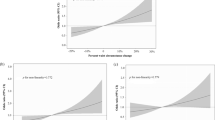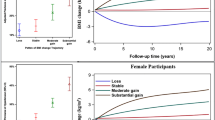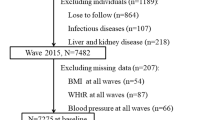Abstract
Single measurements of waist circumference (WC) can predict the incident hypertension, while dynamic change patterns of WC during young adulthood and their association with the incidence of hypertension are poorly demonstrated. This study aimed to identify the longitudinal WC trajectories during young adulthood and explore their association with the risk of incident hypertension. We utilized the data from the China Health and Nutrition Survey (1993–2015) and included 6604 participants aged 18–50 years with repeated WC measurements of 3–8 times and information on incident hypertension. The group-based trajectory model was used to identify WC trajectories. Cox proportional hazard model was conducted to evaluate the association of WC trajectories with the risk of incident hypertension. We identified four distinct WC trajectories during young adulthood. Participants with the low-increasing and the moderate-increasing trajectories had increasing but normal WC, while those with the high-increasing and the sharp-increasing trajectories developed from non-abdominal obesity to abdominal obesity. Compared with the low-increasing trajectory, the adjusted hazard ratios (95% confidence intervals) were 1.48 (1.16–1.89), 2.50 (1.84–3.40), and 3.86 (2.40–6.21) for the moderate-increasing, the high-increasing, and the sharp-increasing trajectories, respectively. After further excluding participants with obesity at baseline, this association did not alter substantially. The gender-specific trajectory analyses yielded similar results. WC trajectories during young adulthood were significantly associated with the risk of incident hypertension in Chinese. Moreover, even the increasing WC trajectory within the normal range during young adulthood might increase the risk of hypertension.
This is a preview of subscription content, access via your institution
Access options
Subscribe to this journal
Receive 12 digital issues and online access to articles
$119.00 per year
only $9.92 per issue
Buy this article
- Purchase on Springer Link
- Instant access to full article PDF
Prices may be subject to local taxes which are calculated during checkout


Similar content being viewed by others
References
Stanaway JD, Afshin A, Gakidou E, Lim SS, Abate D, Abate KH, et al. Global, regional, and national comparative risk assessment of 84 behavioural, environmental and occupational, and metabolic risks or clusters of risks for 195 countries and territories, 1990–2017: a systematic analysis for the Global Burden of Disease Study 2017. Lancet. 2018;392:1923–94.
Luo Y, Xia F, Yu X, Li P, Huang W, Zhang W. Long-term trends and regional variations of hypertension incidence in China: a prospective cohort study from the China Health and Nutrition Survey, 1991-2015. BMJ Open. 2021;11:e042053.
Decoda Study G, Nyamdorj R, Qiao Q, Lam TH, Tuomilehto J, Ho SY, et al. BMI compared with central obesity indicators in relation to diabetes and hypertension in Asians. Obesity. 2008;16:1622–35.
Kawamoto R, Kikuchi A, Akase T, Ninomiya D, Kumagi T. Usefulness of waist-to-height ratio in screening incident hypertension among Japanese community-dwelling middle-aged and elderly individuals. Clin Hypertens. 2020;26:9.
Sebo P, Herrmann FR, Haller DM. Accuracy of anthropometric measurements by general practitioners in overweight and obese patients. BMC Obes. 2017;4:23.
Lee CM, Huxley RR, Wildman RP, Woodward M. Indices of abdominal obesity are better discriminators of cardiovascular risk factors than BMI: a meta-analysis. J Clin Epidemiol. 2008;61:646–53.
Foulds HJ, Bredin SS, Warburton DE. The relationship between hypertension and obesity across different ethnicities. J Hypertens. 2012;30:359–67.
Luo W, Guo Z, Hu X, Zhou Z, Mingwu, Zhang L, et al. A prospective study on association between 2 years change of waist circumference and incident hypertension in Han Chinese. Int J Cardiol. 2013;167:2781–5.
Zhang X, Yao S, Sun G, Yu S, Sun Z, Zheng L, et al. Total and abdominal obesity among rural Chinese women and the association with hypertension. Nutrition. 2012;28:46–52.
Zhao Y, Zhang M, Luo X, Wang C, Li L, Zhang L, et al. Association of 6-year waist circumference gain and incident hypertension. Heart. 2017;103:1347–52.
Ahanchi NS, Tamehri Zadeh SS, Khalili D, Azizi F, Hadaegh F. Sex specific trajectories of central adiposity, lipid indices, and glucose level with incident hypertension: 12 years Follow-up in Tehran lipid and glucose study. J Transl Med. 2021;19:84.
Lynch J, Smith GD. A life course approach to chronic disease epidemiology. Annu Rev Public Health. 2005;26:1–35.
Mi B, Wu C, Gao X, Wu W, Du J, Zhao Y, et al. Long-term BMI change trajectories in Chinese adults and its association with the hazard of type 2 diabetes: evidence from a 20-year China Health and Nutrition Survey. BMJ Open Diabetes Res Care. 2020;8:e000879.
Popkin BM, Du S, Zhai F, Zhang B. Cohort Profile: The China Health and Nutrition Survey-monitoring and understanding socio-economic and health change in China, 1989-2011. Int J Epidemiol. 2010;39:1435–40.
Zhang B, Zhai FY, Du SF, Popkin BM. The China Health and Nutrition Survey, 1989-2011. Obes Rev. 2014;15:2–7. Suppl 1
Nam GE, Cho KH, Han K, Kim CM, Han B, Cho SJ, et al. Obesity, abdominal obesity and subsequent risk of kidney cancer: a cohort study of 23.3 million East Asians. Br J Cancer. 2019;121:271–7.
He D, Sun N, Xiong S, Qiao Y, Ke C, Shen Y. Association between the proportions of carbohydrate and fat intake and hypertension risk: findings from the China Health and Nutrition Survey. J Hypertens. 2021;39:1386–92.
Zhao J, Su C, Wang H, Wang Z, Wang Y, Zhang B. Secular trends in energy and macronutrient intakes and distribution among adult females (1991–2015): results from the China Health and Nutrition Survey. Nutrients. 2018;10:115.
Nagin DS. Group-based trajectory modeling: an overview. Ann Nutr Metab. 2014;65:205–10.
Nagin DS, Odgers CL. Group-based trajectory modeling in clinical research. Annu Rev Clin Psychol. 2010;6:109–38.
Han T, Zhang S, Duan W, Ren X, Wei C, Sun C, et al. Eighteen-year alcohol consumption trajectories and their association with risk of type 2 diabetes and its related factors: the China Health and Nutrition Survey. Diabetologia. 2019;62:970–80.
Karastergiou K, Smith SR, Greenberg AS, Fried SK. Sex differences in human adipose tissues - the biology of pear shape. Biol Sex Differ. 2012;3:13.
Wang L, Lee Y, Wu Y, Zhang X, Jin C, Huang Z, et al. A prospective study of waist circumference trajectories and incident cardiovascular disease in China: the Kailuan Cohort Study. Am J Clin Nutr. 2021;113:338–47.
Chen S, Li W, Jin C, Vaidya A, Gao J, Yang H, et al. Resting heart rate trajectory pattern predicts arterial stiffness in a community-based chinese cohort. Arterioscler Thromb Vasc Biol. 2017;37:359–64.
Wu S, An S, Li W, Lichtenstein AH, Gao J, Kris-Etherton PM, et al. Association of trajectory of cardiovascular health score and incident cardiovascular disease. JAMA Netw Open. 2019;2:e194758.
Jeon J, Jung KJ, Jee SH. Waist circumference trajectories and risk of type 2 diabetes mellitus in Korean population: the Korean genome and epidemiology study (KoGES). BMC Public Health. 2019;19:741.
Li W, Jin C, Vaidya A, Wu Y, Rexrode K, Zheng X, et al. Blood pressure trajectories and the risk of intracerebral hemorrhage and cerebral infarction: a prospective study. Hypertension. 2017;70:508–14.
Araujo J, Barros H, Ramos E, Li L. Trajectories of total and central adiposity throughout adolescence and cardiometabolic factors in early adulthood. Int J Obes. 2016;40:1899–905.
Walls HL, Stevenson CE, Mannan HR, Abdullah A, Reid CM, McNeil JJ, et al. Comparing trends in BMI and waist circumference. Obesity. 2011;19:216–9.
de Toro-Martin J, Guenard F, Tchernof A, Deshaies Y, Perusse L, Biron S, et al. A GWAS follow-up of obesity-related SNPs in SYPL2 reveals sex-specific association with hip circumference. Obes Sci Pr. 2016;2:407–14.
Alkerwi A, Crichton GE, Hebert JR. Consumption of ready-made meals and increased risk of obesity: findings from the Observation of Cardiovascular Risk Factors in Luxembourg (ORISCAV-LUX) study. Br J Nutr. 2015;113:270–7.
Zhang C, Rexrode KM, van Dam RM, Li TY, Hu FB. Abdominal obesity and the risk of all-cause, cardiovascular, and cancer mortality: sixteen years of follow-up in US women. Circulation. 2008;117:1658–67.
Fu S, Luo L, Ye P, Liu Y, Zhu B, Bai Y, et al. The abilities of new anthropometric indices in identifying cardiometabolic abnormalities, and influence of residence area and lifestyle on these anthropometric indices in a Chinese community-dwelling population. Clin Inter Aging. 2014;9:179–89.
Acknowledgements
We thank the staff and participants of the CHNS.
Author information
Authors and Affiliations
Corresponding authors
Ethics declarations
Competing interests
The authors declare no competing interests.
Additional information
Publisher’s note Springer Nature remains neutral with regard to jurisdictional claims in published maps and institutional affiliations.
Supplementary information
Rights and permissions
About this article
Cite this article
Cheng, C., Li, Y., Ma, W. et al. Trajectories of waist circumference during young adulthood and incident hypertension: the China Health and Nutrition Survey. J Hum Hypertens 36, 767–774 (2022). https://doi.org/10.1038/s41371-021-00563-y
Received:
Revised:
Accepted:
Published:
Issue Date:
DOI: https://doi.org/10.1038/s41371-021-00563-y



